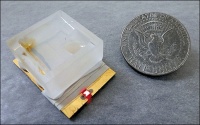The sensor, developed at The University of Texas at Austin, is built with an LED light, aluminium foil, gelatine, milk protein and other easily obtainable materials.
The sensor could help prevent damage from acute pancreatitis, which is a sudden inflammation of the pancreas that can lead to severe stomach pain, nausea, fever, shock and sometimes death.
The matchbox-sized sensor is said to rely on a simple two-step process to diagnose the disease.
In step one, blood extract is placed on a layer of gelatine and milk protein. If there are high levels of trypsin, an enzyme that is overabundant in the blood of patients with acute pancreatitis, the trypsin will break down the gelatine in much the same way it breaks down proteins in the stomach.
In step two, a drop of sodium hydroxide (lye) is added. If the trypsin levels were high enough to break down that first barrier, the sodium hydroxide can trickle down to the second barrier, a strip of tin foil, and set about dissolving it.
The foil corrodes, and with both barriers now permeable, a circuit is able to form between a magnesium anode and an iron salt at the cathode. Enough current is generated to light up a red LED. If the LED lights up within an hour, acute pancreatitis is diagnosed.
Brian Zaccheo, a graduate student in the lab of Richard Crooks, professor of chemistry and biochemistry, has a provisional patent and envisions a number of potential uses for the sensor.
It might help health providers in the developing world who don’t have the resources to do the more complex tests for pancreatitis; or it could be of use in situations where batteries are in short supply, such as after a natural disaster or in remote locations.





Glasgow trial explores AR cues for autonomous road safety
They've ploughed into a few vulnerable road users in the past. Making that less likely will make it spectacularly easy to stop the traffic for...